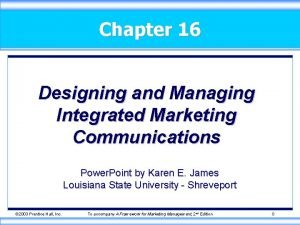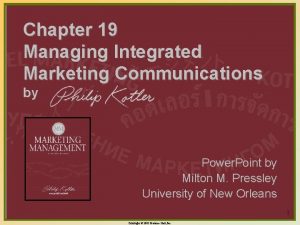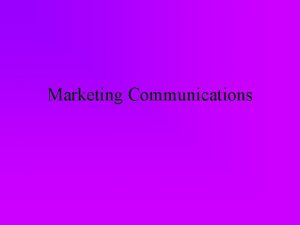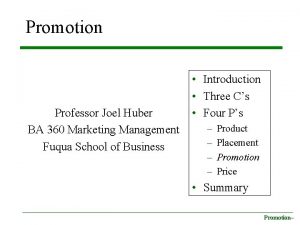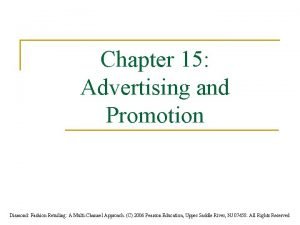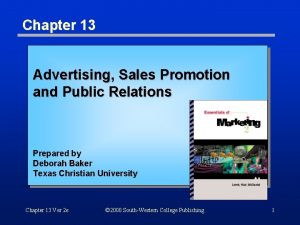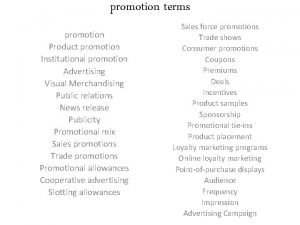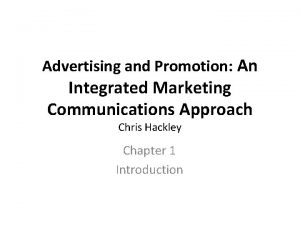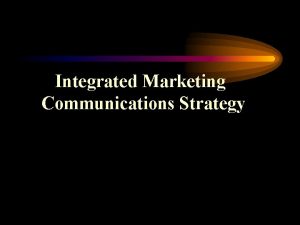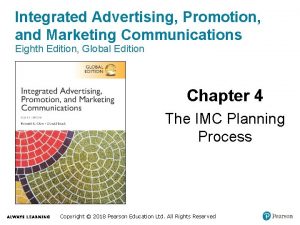Advertising and Promotion An Integrated Marketing Communications Approach
















- Slides: 16

Advertising and Promotion: An Integrated Marketing Communications Approach Chris Hackley Chapter 6 Non-Advertising Promotion in Integrated Marketing Communication

Indicative Chapter 6 content • • • Non-advertising techniques in the promotional mix Sponsorship Product placement Corporate communication and public relations Other elements of the promotion mix

Non-advertising techniques in the promotional mix • Advertising is evolving new forms in concert with developments in digital communications and the thrust for integrated communications planning • These new forms challenge traditional classifications of the promotional mix • Non-advertising promotion has assumed greater importance in the media mix • Brands clients want to see the brand values across several platforms simultaneously in ‘through-the-line’ or ‘integrated’ campaigns

Non-advertising promotion • So, for example, internet sites carry banner advertising but also include click-through links and pop-ups; outoor billboards carry traditional posters but can also be adapted to carry electronic images or images which will change depending on the angle from which they are viewed; a celebrity might appear as an actor, without speaking directly to camera, in a traditional TV ad; and television advertisements may have a website address listed for further information

Advertising evolving • Therefore traditional advertising takes on a hybrid character as it merges with non-advertising techniques such as the internet and web 2. 0, static advertising merges with moving advertising, and traditional TV advertising merges with celebrity endorsement

Sponsorship • Sponsorship entails a brand gaining publicity through an acknowledged association with another brand, activity or organization • Growth in sponsorship has been rapid over the past three decades: the sum spent on sponsorship in the UK rose from £ 105 million in 1982 to £ 781 million in 2001 and is expected to reach £ 940 million in 2006 http: //www. sponsormap. com/global-sponsorship-spend-remains-positive-for 2009/ accessed May 18 th 2009

Sponsorship activities • Sponsorship was originally seen as a part of public relations since it offers a support medium to mainstream advertising and is not necessarily as explicit as advertising • Television sponsorship maintains a high profile and has been common in the USA from the beginning of the television era in the 1950 s

Product placement • Product placement (also called brand placement or embedded marketing) refers to brands featured as scene props or script references in entertainment vehicles such as movies, TV shows, pop songs, novels, radio broadcasts, computer games or stage plays • Its appeal is that it is an implicit promotion which is experienced as part of entertainment • Consequently the implied associations are not as critically scrutinized as more explicit claims are in conventional advertising • It also represents good value compared to spot ads

Corporate communication • Corporate communication intersects marketing and branding at product and market levels in the sense that it offers an overarching set of values and imagery which should, ideally, dovetail with those of brands at other levels of the corporation • In many cases, the corporate brand is the most highly visible, as with Coca-Cola, Nike and Ryanair. While in other cases brands at the product/market level may have a higher profile than the corporate brand • Unilever has taken a decision to feature its corporate brand more strongly, which represents a change of policy because for many years it was almost anonymous while its brands were well known

Public Relations • The Institute of Public Relations (IPR), the main professional body for the discipline in the UK, defines public relations as ‘the planned and sustained effort to establish and maintain goodwill and understanding between an organization and its publics’ (Harrison, 1995: 2) • The Public Relations Society of America (PRSA) emphasizes PR’s task of helping an organization to interact, communicate with and win the cooperation of its public • PR is a function where the aim is to create goodwill towards the brand or the corporation, to deflect criticism, or to foster a generally positive view of the corporation or brand among stakeholders and the general public

Other elements of the promotion mix • • Direct mail and direct response Internet Sales promotion Trade conferences and exhibitions Ambient; viral, buzz and guerrilla marketing Point of sale and merchandising Personal selling and word-of-mouth

Chapter 6 review questions 1 • Video an evening’s TV viewing on commercial channels. Play back the video and list the number of sponsorship and product placement events. Categorize these using the categories explained in this chapter. What do the results tell you about the changing practices of sponsorship and brand placement on broadcast entertainment? What impact do you feel such events have in comparison with conventional TV advertising? Has the character of TV advertising changed to reflect the growth in sponsorship and its variants?

2 • How can the sponsorship of TV shows generate tangible benefits for brand organizations?

3 • Discuss the possibilities and limitations of IMC as an approach to promotion and marketing communication. Can you think of examples of IMC practice?

4 • Imagine that you are the public relations officer of a soccer club, a university or a retail organization. Think of six ways in which you could draw on other communications disciplines to promote a positive public perception of your organization.

5 • What is meant by the phrase ‘the entertainment economy’? What are the major features of the entertainment economy? Form two groups to debate the social implications of the entertainment economy and the economic benefits.
 Integrated brand management
Integrated brand management Amplified expressiveness
Amplified expressiveness Designing and managing integrated marketing communications
Designing and managing integrated marketing communications Amplified expressiveness
Amplified expressiveness Managing integrated marketing communication process
Managing integrated marketing communication process Designing and managing integrated marketing channels
Designing and managing integrated marketing channels Easa advertising
Easa advertising The product of a sender's encoding is the
The product of a sender's encoding is the Integrated marketing communications definition
Integrated marketing communications definition Coca cola push and pull strategy
Coca cola push and pull strategy Overview of integrated marketing communications
Overview of integrated marketing communications 360 advertising marketing & promotion
360 advertising marketing & promotion Difference between advertising and sales promotion
Difference between advertising and sales promotion Difference between advertising and sales promotion
Difference between advertising and sales promotion Retail advertising and promotion jay diamond
Retail advertising and promotion jay diamond Public relations sales promotion
Public relations sales promotion Advertising management and sales promotion
Advertising management and sales promotion


